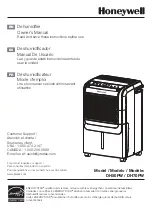
www
.
W
elltec
.
pro
55
b.
Isolate the system electrically.
c.
Before starting the procedure, ensure that:
•
mechanical devices for transporting refrigerant cylinders are available if required;
• personal protective equipment is available and correctly used;
• the refrigerant recovery process is constantly supervised by a qualified person;
• recovery equipment an
d cylinders meet the relevant standards.
d.
If possible, pump refrigerant out of the system.
e.
If vacuum is not possible, a manifold must be provided to remove refrigerant from various parts of the system.
f.
The cylinder should be placed on the scale before starting the recovery procedure.
g.
Start the recovery device that must be operated according to the manufacturer's instructions.
h.
Do not overfill the cylinder. (Do not exceed 80% of the liquid volume).
i.
Do not exceed the maximum cylinder operating pressure, even temporarily.
j.
After the bottles have been properly filled and the process is completed, immediately remove the bottles and equipment from
the installation site and check that all shut-off valves of the device have been closed.
k.
The recovered refrigerant should not be introduced into another refrigerant system unless after cleaning and checking.
15.
Labeling
The device should be marked out of service and emptied of refrigerant. The marking must be dated and signed. Make sure that
there are stickers on the device indicating that there is flammable refrigerant inside.
16.
Refrigerant recovery
When removing refrigerant from the system for service or decommissioning, it is recommended that refrigerants be removed safely.
When transferring refrigerant to cylinders, use only cylinders adapted for refrigerant recovery. Make sure that the correct number
of cylinders is available to accommodate all refrigerant. All cylinders used must be intended for refrigerant recovery and bear the
refrigerant name (i.e. special cylinders for recovered coolant). Cylinders should be equipped with a pressure relief valve with shut-
off valves in good technical condition. Empty cylinders must be emptied and cooled as far as possible before recovery of the
refrigerant.
Recovery equipment should be functional, equipped with a set of instructions and be intended for the recovery of flammable
refrigerants. In addition, a set of functional and calibrated scales should be prepared. The hoses must be fitted with tight shut-off
fittings in good condition. Before using recovery equipment, check the condition, correct maintenance and all related electrical
parts are tightly closed to prevent ignition in the event of refrigerant release. If in doubt, consult the manufacturer.
The recovered refrigerant should be handed over to the refrigerant supplier in the appropriate cylinder. In addition, a waste transfer
card should be made. Do not mix refrigerants in recovery equipment, especially in cylinders. When removing compressors or
compressor oils, remove sufficient oil to prevent flammable refrigerant from remaining in the grease. The draining process must be
carried out before returning the compressor to the supplier. Only the electric heating of the compressor body should be used to
speed up this process. Use caution when removing oil from the system.
Summary of Contents for DHN20
Page 2: ...v 1 05 ...
Page 3: ...www Welltec pro 1 Polski 2 28 English 29 56 ...
Page 59: ......
Page 60: ...www welltec pro store kontakt https welltec pro store kontakt ...




































